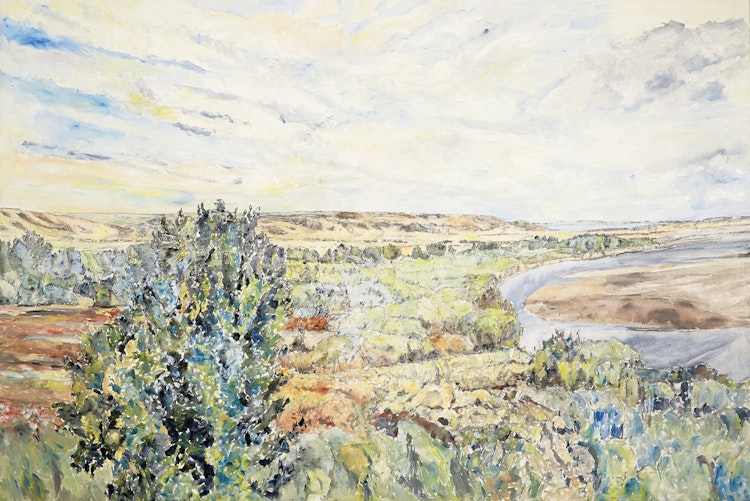The River with Hills by Dorothy Elsie Knowles

Dorothy Knowles
The River with Hills
acrylic on canvas
signed, titled, dated May 8, 1986 and inscribed “AC-20-86” on the reverse
49.25 x 73.5 ins ( 125.1 x 186.7 cms )
Auction Estimate: $15,000.00 - $20,000.00
Price Realized $24,780.00
Sale date: May 29th 2018
Private Collection, Toronto
From these Emma Lake workshops, Dorothy Knowles took art critic Clement Greenberg’s advice to continue painting from nature and she discovered the importance of working en plein-air. The artist found it difficult to find time to station herself outside for extended periods of time to paint while raising her three daughters. She produced some finished paintings outdoors but she often made sketches and took photographs to use back in the studio. “The River with Hills”, dating to 1986, would have been painted after her children had grown, thus enabling her to spend more time outside.
Share this item with your friends
Dorothy Elsie Knowles
(1927 - 2023) RCA
Dorothy Elsie Knowles was born on April 7, 1927 in Unity, Saskatchewan. She grew up on a farm overlooking a Prairie valley and initially had no plans to become a painter, studying biology at the University of Saskatchewan in Saskatoon between 1944 and 1948. At the time of her graduation, a friend persuaded her to enroll in a six-week summer course given by the University of Saskatchewan at Emma Lake. The course was led by Reta Cowley from Saskatoon and James Frederick Finley from the Ontario College of Art and under their guidance young Dorothy found a proclivity for art. Upon her return to Saskatoon she continued to study painting under Eli Bornstein and Nicholas Bjelejac at the University of Saskatchewan between 1948 and 1952. She then attended summer courses at Emma Lake where she studied under Will Barnett, Clement Greenberg, Jules Olitski, Joe Plaskett, Kenneth Noland and Lawrence Alloway. In 1951 she studied briefly at the Goldsmith School of Art in London, England. She married William Perehudoff and they travelled to France (Paris) and Italy in 1952.
Returning to Canada with her husband she held her first one man show in 1954 at the Saskatoon Art Centre (1963); Regina Public Library (1963); The Mendel Art Gallery, Saskatoon (1964); The David Mirvish Gallery, Toronto (1965); Bonli Gallery, Toronto (1967); at the Moos Jaw Art Museum, Saskatchewan (1968) when the Moose Jaw “Times Herald” noted, “Her show consists of 12 paintings which are mainly of northern Saskatchewan and the Saskatoon area, ‘I chose the paintings from my most recent work,’ she said. Speaking at the opening were Mrs. Joan Rankin chairman of the art museum board and Mayor L.H. Lewry. Mrs. Rankin and Miss Knowles is ‘one of the finest landscape artist in Canada. She proves to us that landscape painting is still a real and important art form.”
In the 1960's, when artist's and critics workshops were de rigueur, she attended workshop by the American painter Herman Cherry (1961), the critic Clement Greenberg (1962), Kenneth Noland (1963), Jules Olitski (1964), Lawrence Alloway (1965), and Michael Steiner (1969). All of these had varying degrees of influence on her work, changing her style from a heavy impasto favoured by Greenberg to a more fluid technique preferred by Noland. Most importantly she discovered the importance of working directly from nature. Thus, weather permitting , she worked out of doors, at times producing finished paintings, at times sketches and photographs which she used in the studio. However, her technique was fundamentally different from that employed most visibly by the Group of Seven. While the studio works by members of the Group differ drastically from their essential out-of-doors sketches, Knowles uses both nature and photographs from nature in the same manner so that the results are in every respect comparable.
In 1967 Marie Nagel of the “Star-Phoenix”, Saskatoon, explained, “She says she has beat the problem of mosquitoes flying into her paintings, and dust blowing onto them, by buying a large van from which she often paints. “I develop my own technique directly from nature,’ said Mrs. Perehudoff, explaining that she tries to integrate her charcoal sketches on the canvas with the paint, using it very thinly so the charcoal shows through and becomes a part of it… Mrs. Perehudoff says it takes her from a week to a month to complete a painting and there’s more of it than just sketching and painting. Canvas sheets must be stretched over wooden stretcher frames, and must also be sized before they are ready to be painted on, she said. Besides painting, the Perehudoffs are collectors of paintings and pottery. They have a large library, and find enjoyment through music and books….”
Dorothy is represented in the following public collections: The Willistead Museum at Windsor, Ontario; the Hamilton Art Gallery; the Art Gallery of Ontario; the University of Saskatchewan; the Saskatchewan Arts Board collection, amongst many others.
Source: "A Dictionary of Canadian Artists, Volume 3: Jacobi-Lismer", compiled by Colin S. MacDonald, Canadian Paperbacks Publishing Ltd, Ottawa, 1979

